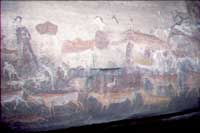|
|
 |
ROCK ART AT RICE
DISCOVERING
SOUTHERN AFRICAN ROCK ART
Extracts from an article
by Jamie Hampson, MA (Oxon)
Eight years ago, two
South African archaeology students were walking in the breathtaking Drakensberg
Mountains, a hundred miles inland from Durban. Above them loomed towering
basalt cliffs reaching to 7000 feet. As the sun began to set after a hard
day’s searching for ancient rock paintings, they made their way back
to camp. Suddenly, a ferocious lightning storm struck. One of the students
pointed to a rock shelter at the top of a steep hill to the west; both
climbed as quickly as possible in a desperate bid to avoid the eye of
the storm.
Earlier, and from
a distance, they had been arguing whether the rock shelter contained paintings.
At first, as the two of them recovered their breath, it seemed that there
was none. Then, a flash of color caught their eyes. Hidden behind a fallen
boulder was a 20-foot panel containing 231 awe-inspiring images. Appropriately
enough, they named their find ‘Storm Shelter’.
Photo: G Blundell. Click to enlarge
Storm Shelter is now
recognized as one of the great discoveries of recent times. It was featured
in the February 2001 issue of National Geographic and on the cover of
the South African Journal of Science.
Until recently it
was assumed that all of the large and spectacular rock art sites in southern
Africa had been found. During the last two decades, however, dozens of
remarkable discoveries, such as Storm Shelter, have put paid to that assumption.
Researchers, landowners, journalists and members of the public are showing
more and more interest in rock paintings (pictographs) and engravings
(petroglyphs) throughout the sub-continent. In 2001 the Minister of Arts,
Culture, Science and Technology in South Africa unveiled a spectacular
reproduction of Storm Shelter in Pretoria, the nation’s capital.
At last, some of the world’s earliest art traditions are receiving
the attention they deserve.
San beliefs and
southern African rock art
All too often, articles
on southern African rock art imply that little is known about the San
(more famously known as Bushmen), hunter-gatherers who populated the whole
of southern Africa for many millennia. In fact, despite widespread decimation
by both black and white settlers, several San groups survive in the Kalahari
Desert in Botswana and Namibia. Thanks to the work of anthropologists
during the last few decades, and also to ethnographic records from the
nineteenth century, we are fortunate to know much about the San way of
life, complex religion and deeply religious rock art.
The central tenet
of San religion was (and still is) ritualized interaction between the
‘real’ (material) and spirit worlds. The San cosmos has three
levels. The spirit world—both above and below the real world—is
connected to the material world by places such as waterholes (places of
transformation and breakthrough) that feature prominently in San myths
and beliefs. For the San, the spirit world is never far away. It impinges
on daily life, and, as we shall see, this overlap of realms can be clearly
seen in the rock art itself.
Movement between
the material and spirit realms in the San cosmos is achieved by shamans
or ‘medicine people’ . These ritual specialists are believed
to have the power to alter the weather, heal the sick and to control the
movements of animals. Shamans enter a state of trance (or altered state
of consciousness) by intense dancing, audio-driving and hyperventilation.
Unlike many other hunter-gatherer societies around the world, they do
not rely on the ingestion of hallucinogens. Shamans—both male and
female—harness spiritual potency by dancing around the campfire while
women clap ‘medicine songs’; in this way the shamans are transported
to the spirit world.
The fact that the
San belief-system has lasted for many thousands of years explains why
the oldest images of which we know (about 27,000 years old, in Namibia)
possess elements similar to the most recent San depictions (produced about
100 years ago).
Shamanic (or trance)
dances, as well as individual elements of the dances, are depicted in
the art. Human figures, for example, are often in a bending-forward posture.
Today San shamans in the Kalahari say that, as potency boils in their
stomachs, their muscles contract and they bend forward, often requiring
the aid of one or two ‘dancing sticks’. Sometimes when this
happens shamans suffer nosebleeds. The San believe that the smearing of
nasal blood on people keeps sickness away.
Hand-to-nose postures
are also found in the art. These are probably connected with the potency
of nasal blood, but they also have a greater significance: some San groups
used their word for ‘nose’ also to mean a shaman’s ability
to enter trance and thus the spirit world.
Fundamentally, the
art presents the shamans’ privileged view of the trance dance and
of the spirit world to which they are transported. This ‘shaman’s
eye’ view explains why there are so many ‘non-real’ images
in the art. In addition to spirits leaving the top of people’s heads,
sickness expelled through a ‘hole’ in the back of a shaman’s
neck, and malevolent spirits of the dead encountered in the underworld,
there are also numerous depictions of therianthropes (part-human, part-animal
figures; see photo 3/5 in the Image Database),
‘flying’ bucks (antelope) and other unusual creatures. San art—like
much hunter-gatherer rock art throughout the world—is about the ‘re-creation’
of shamans’ visions of the spirit world. In fact, the paintings were
considered powerful ‘things in themselves’. Inherently potent
blood was often used as a binder to adhere the pigments (e.g., ochre,
clay, charcoal) to the rock face.
Before the use of San ethnography, a straightforward analogy had been overlooked: The stained glass windows of European cathedrals cannot be understood without some knowledge of Christianity; similarly, San rock art cannot be understood without some insight into San beliefs.
